|
|||||||||
|
FEATURESThe Southern Expeditions of Emperors Kangxi and Qianlong Fig. 1 Painting showing the Kangxi Emperor seated before the central mast of a vessel during a southern inspection tour. Wang Hui (1632-1717) and assistants, The Kangxi Emperor's Southern Inspection Tour, Scroll Eleven: Nanjing to Jinshan (close-up detail from second half of scroll), handscroll, colour on paper, Palace Museum, 67.8 x 2612 cm, cat. no.Gu9208, China: The Three Emperors, 1662-1795, pp.88-89. The Manchu rulers of the Qing dynasty (1644-1911) inherited the Grand Canal which linked the north and south of the country and connected the major river systems running from west to east. Hailing from the mountains, forests, meadows and wetlands of China's north-east beyond the Great Wall, the Manchus succeeded in traversing the barrier that had delineated the practices of settled agriculture and nomadic herding. They would create an empire that straddled both sides of the walls and that extended across Mongolia, north into southern Siberia and across to Central Asia. Overseeing the transport lines that maintained the Manchu northern court was a major task of the Kangxi and Qianlong emperors who ruled China during its historically highest levels of prosperity in the 17th and 18th centuries. They did this by reviving a hallowed ancient Chinese political practice, the imperial tour of inspection, or 'imperial progress'. 'Tours of inspection to the south' (nanxun) down the Grand Canal, as well as by road, became major events in the imperial administration of these Manchu rulers. (Figs.1, 2, 3&4) In perhaps a subtle reference to the success of the economic policies, and political achievements, of these two emperors, Deng Xiaoping, in early 1992, himself undertook what was officially described as 'a tour of inspection to the south' (nanxun), by travelling to Shanghai and Guangdong province. It signalled to the nation the Communist Party's commitment to economic reform and market prosperity after some years of lassitude following the events of the spring of 1989. 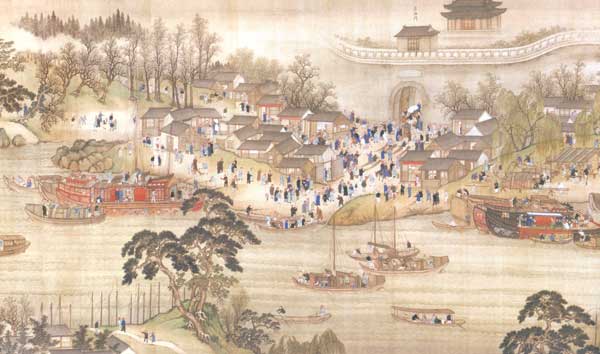 Fig. 2 Wang Hui (1632-1717) and assistants, The Kangxi Emperor's Southern Inspection Tour, Scroll Eleven: Nanjing to Jinshan handscroll, colour on paper, Palace Museum, 67.8 x 2612 cm, cat. no. Gu9208, China: The Three Emperors, 1662-1795, London: Royal Academy of Arts, 2005, p.30. 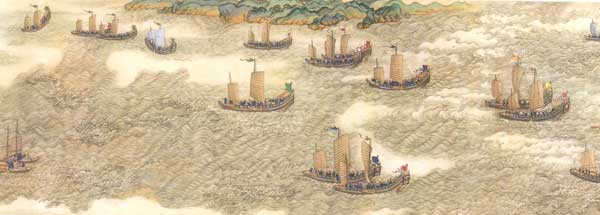 Fig. 3 Wang Hui (1632-1717) and assistants, The Kangxi Emperor's Southern Inspection Tour, Scroll Eleven: Nanjing to Jinshan (detail from second half of scroll) handscroll, colour on paper, Palace Museum, 67.8 x 2612 cm, cat. no. Gu9208, China: The Three Emperors, 1662-1795, p.30 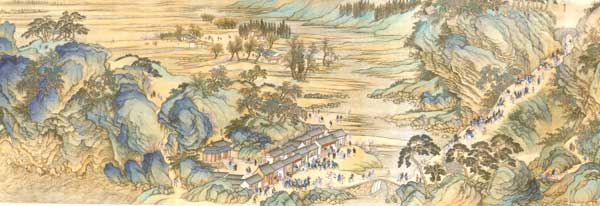 Fig. 4 Wang Hui (1632-1717) and assistants, The Kangxi Emperor's Southern Inspection Tour, Scroll Eleven: Nanjing to Jinshan (detail from second half of scroll showing some of the emperor's party in the outskirts of Nanjing), handscroll, colour on paper, Palace Museum, 67.8 x 2612 cm, cat. no. Gu9208, China: The Three Emperors, 1662-1795, pp.86-87. Imperial ExpeditionsThe persistence of the associations of the imperial tour of inspection (variously termed xun and xunshou) to the present day reminds us that the terms already had ancient associations during the reigns of Kangxi (r.1662-1722) and Qianlong (r.1736-1795). The legendary ruler Shun is said to have embarked on a tour of inspection that lasted for a year, travelling to the nation's sacred mountains where he offered sacrifices. For him, the tour was an extended religious pilgrimage, but over time the ritual dimension of the institution he is credited with establishing became more political. Such tours could be conducted wherever the monarchical sway extended. During the Western and Eastern Zhou dynasties, inspection tours took rulers to the domains of those who owed them allegiance. 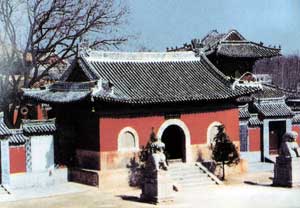 Fig. 5 Photograph of the xinggong (imperial lodge) of the Qianlong Emperor in Zaohe, Huaiyin. Source: An Zuozhang, Zhongguo yunhe wenhua shi, vol.1, n.p. China's first emperor, known to history as Qin Shihuang (r.221-210 BCE), adopted the inspection tour, even though he ostensibly abandoned so many of the ritual accoutrements of the earlier Zhou court and its vassals, among which the state of Qin had once numbered. However, most of Qin Shihuang's 'tours of inspection' were to the eastern seaboard, and beyond it the 'Isles of the Immortals'. Various archaeologically investigated or historically 'remembered' sites along the coasts of Hebei and Liaoning provinces pay tribute to the hubris of the first emperor who eagerly sought the elixir of immortality and attempted to assemble fleets to set sail to the legendary land of Fusang to obtain it. Two possible monuments to this endeavour can be seen in the seaside resort of Beidaihe in Hebei (now a popular summer resort town for the party nomenklatura and the cashed-up alike), where a stone plinth of dubious antiquity documents this early tour of inspection and an unexcavated site on a hilltop overlooking a naval base has been identified by archaeologists as the possible location of an imperial lodge or detached palace (xinggong) that was constructed for his residence during one of these expeditions. 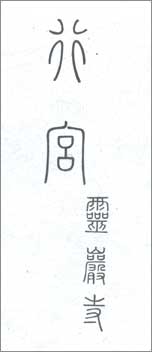 Fig. 6 'The 'travelling palace' (xinggong) is given prominence among the illustrations of 'landmarks' (mingsheng) visited during the southern progresses appended to Nanxun shengdian (fasc.95-fasc.100). The title page for each separate illustration gives prominence to the function of the landmark as a 'travelling palace' rather than as 'site,' as in this leaf preceding this illustration of Lingyan Temple in Nanxun shengdian, Taipei: Xinxing Shuju, 1979, p.5303.
Fig. 6 'The 'travelling palace' (xinggong) is given prominence among the illustrations of 'landmarks' (mingsheng) visited during the southern progresses appended to Nanxun shengdian (fasc.95-fasc.100). The title page for each separate illustration gives prominence to the function of the landmark as a 'travelling palace' rather than as 'site,' as in this leaf preceding this illustration of Lingyan Temple in Nanxun shengdian, Taipei: Xinxing Shuju, 1979, p.5303.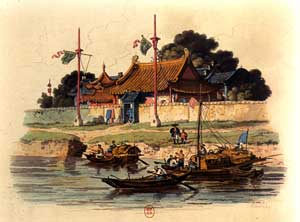 Fig. 7 A mandarin's residence along the Grand Canal, watercolour, original in British Library manuscript. From Alain Peyrefitte, The collision of two civilisations: The British Expedition to China 1792-4, London: Harvill, 1993. The xinggong (also called jiangong, meaning 'simple or abbreviated palace') was an architectural form born of such imperial tours. The use by an emperor of xinggong accommodation was intended to remind subjects of the emperor's self-sufficiency, modesty of means and refusal to accept lavish accommodation provided by local hosts. (Fig.5) Attention to this tradition is evident in the albums of illustrations recording southern expeditions of Qianlong,[1] in which many leaves were devoted to woodblock illustrations of imperial lodges, reminding us that these were often modest quarters adjoining temples, officials' residences or areas set aside in government offices, such as the Silk Manufacture Comptroller in Jiangning (Nanjing). (Figs. 6&7) Prior to the Qing dynasty, it was the martial conquerors, such as Qin Shihuang and Han Wudi (r.140-87 BCE), who were most active in employing the institution of the tour of inspection. Emperor Sui Yangdi (r.605-618), who constructed the Grand Canal, was also an intrepid inspector of his realm, his favoured modes of transport being a dragon flotilla and a carriage fitted out for the pleasures of silken bondage, but the lavishness of his expenditures drained the nation's coffers. Nonetheless, the Grand Canal laid the foundation for the prosperity of the subsequent Tang dynasty (618-907). The Tang emperors perpetuated the institution within narrow ritualised parameters, and generally confined their touring to ritual visits to the Confucian Temple at Mount Taishan. Howard Wechsler points out that the formal tour of inspection in which the emperor, court and army travelled en masse had, by its very nature, to be used sparingly by any regime. In his study of Tang ritual, he noted the recent excesses of Emperor Sui Yangdi in this regard provided ample warning for the early Tang emperors.[2] Emperor Gaozong (r.626-249) made the fullest use of xunshou among the early Tang emperors, but Empress Wu may have encouraged him in this. At any rate xunshou were not lightly embarked upon, and the early Tang emperors cannot be said, overall, to have exceeded the rule in Shang shu (The Book of History) that only one tour every five years should be undertaken by a ruler. In the Qing Dynasty Fig. 8 Wang Hui (1632-1717) and assistants, The Kangxi Emperor's Southern Inspection Tour, Scroll Eleven: Nanjing to Jinshan (detail from second half of scroll showing vessels of imperial fleet), handscroll, colour on paper, Palace Museum, 67.8 x 2612 cm, cat. no. Gu9208, China: The Three Emperors, 1662-1795, pp.86-87 Following the Tang, the institution of the tour of inspection was not revitalised until the Qing dynasty. The reign of the Kangxi Emperor saw the consolidation of Qing power and the ushering in of a new period of prosperity. In the course of his sixty-one year long reign, Kangxi undertook six southern expeditions (in 1684-5, 1689, 1699, 1704, 1705 and 1707). (Figs.8, 9&10) He was well aware that the 'tour of inspection' provided an excellent institution for bringing a recalcitrant south to heel, and he often alluded to the tours of inspection of Zhou, Qin, Han and Tang dynasties to enlist the allegiance of his Han Chinese constituents. The pattern of regular southern expeditions was repeated by his grandson, the Qianlong Emperor, and he too consciously evoked the images of expeditions by empire-building predecessors.  Fig. 9 Wang Hui (1632-1717) and assistants, The Kangxi Emperor's Southern Inspection Tour, Scroll Eleven: Nanjing to Jinshan (detail from second half of scroll showing vessels from imperial fleet sailing down the Yangtze), handscroll, colour on paper, Palace Museum, 67.8 x 2612 cm, cat. no. Gu9208, China: The Three Emperors, 1662-1795, pp.86-87. Apart from their southern inspections along the Grand Canal, the Kangxi and Qianlong emperors also undertook 'tours of inspection' to Shandong, to their north-eastern homeland in Manchuria and to various sacred sites, including Wutai Mountain. It was, however, their southern tours that were the centrepiece of their interaction with their Chinese subjects, at the same time as being indicative of the peripatetic nature of the Qing court, which moved at various times of the year from the Forbidden City in Beijing, to the Yuanming Yuan garden palace north-west of the capital, and in the heat of summer to the Imperial Mountain Lodge at Jehol and the Mulan hunting grounds. 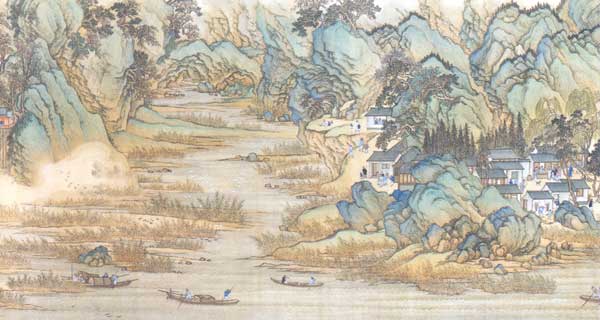 Fig.10 Wang Hui (1632-1717) and assistants, The Kangxi Emperor's Southern Inspection Tour, Scroll Eleven: Nanjing to Jinshan (detail from second half of scroll showing a secluded cove with water birds adjacent to Hongji Temple), handscroll, colour on paper, Palace Museum, 67.8 x 2612 cm, cat. no. Gu9208, China: The Three Emperors, 1662-1795, pp.86-87. The Kangxi EmperorIn the years of warfare that followed the Manchu invasion, the waterways and rivers of eastern and southern China were neglected, resulting in increased flooding. On assuming the throne, the Kangxi Emperor determined that the three major tasks he must tackle were: the insurgency of 'the three feudatory rulers' (Sanfan) in the south of China; 'management of the Yellow River' (zhihe) and other waterways; and, the regularisation of shipments of tributary grain from the south. According to a note in 'The Biography of Jin Fu' in Qing shi gao (Draft history of the Qing dynasty), he penned a pledge to this effect on a column in the palace to signal his determination. The heavy load of sediment carried downstream by the Yellow River in spring and summer meant that the river could shift course after flooding. At the beginning of Kangxi's reign, the river no longer flowed into the ocean in Henan but in northern Jiangsu, and, in the vicinity of Huaiyin, it flowed dangerously close to the confluence of the Huai River and the Grand Canal, posing the threat of massive flooding. An excessive overflow from the Yellow River also debouched into the Grand Canal itself, both impeding the flow of the river itself and making transport along the Grand Canal virtually impossible. Not only was dredging necessary, but retaining walls also needed to be repaired or rebuilt, if the Yellow River were to keep to its new course. These engineering tasks needed to be tackled to maintain the required annual flow of four million dan (a unit of dry measure, equivalent to 100 litres) of rice transported from the south to the hungry capital, essential if social order and imperial rule were to be maintained. 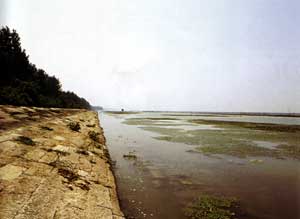 Fig.11 Photograph of Hongze Lake and its embankment. This embankment extends all the way from Matouzhen in Huai'an to the north, down to Jiangtouzhen in Huai'an county to the south. The stone embankment has a total length of 67 km. Repair work was carried on the embankment in 1965. Source: Photograph by Li Dihua, published in Zhongguo wenhua yichan, 2006:1, p.25. The early hydraulic work under Kangxi focused on Qingkou (today's Qinjiang city, Jiangsu) to the east of Hongze Lake, (Fig.11) where the Yellow and Huai rivers converged and threatened the Grand Canal. Following severe flooding in 1676, the emperor despatched Jin Fu (1633-1692) to take charge of Yellow River management, and in 1684 Kangxi undertook his first voyage of inspection to see how these engineering efforts had progressed. Inspecting water management projects became a duty he assumed during his subsequent five tours, and in the course of these the emperor's thinking on water control underwent a change. When, in early 1685, the emperor first saw the destruction to farmers' houses and fields in Qinghe county, Huai'an prefecture and at Gaoyou Lake, he was prompted to relieve the farmers' plight by advocating that a policy of dredging at the mouth of the Yellow River be implemented, even though this brought him into conflict with Jin Fu. The dredging resulted, however, in sea water travelling inland for a greater distance, after which the Emperor acknowledged that the policies he had been encouraging were misguided and that Jin Fu's had been well conceived. 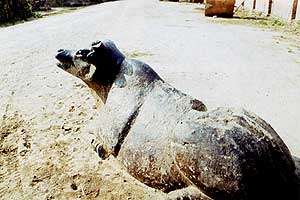 Fig.12 Photograph of the Iron Ox at Jiangdu. Located below the dykes of the Grand Canal west of Shaobozhen town under the jurisdiction of Jiangdu city, the ox was cast in 1701, during the reign of the Kangxi Emperor, and originally positioned beside the canal to act as a water guardian. The photograph shows the state of preservation of the ox in the 1980s. Photograph by Liu Shizhao, published in Zhongguo wenhua yichan, 2006:1, p.22. As early as 1687, Jin Fu had presented a plan for controlling flood waters in central Jiangsu by constructing a dyke parallel to the one along the eastern shore of Hongze Lake, which would divert waters northward to Qingkou and southwards towards the Yangtze River. This plan was opposed by other officials, but in the meantime Jin Fu had successfully overseen the construction of a canal called Zhonghe, which was approximately 150 kilometres in length and ran parallel to the Yellow River north of Qinghe, thereby mitigating the danger to grain transport in that section of the Yellow River.[3] After many years of personal experience, the emperor adopted a new policy stressing that the key to management of the Yellow River lay in handling the water-flow better upstream, but it was only during Kangxi's third expedition in 1699 that Jin Fu's plan of 1687 was finally adopted and sound measures for handling water flow were implemented. The bed of the Yellow River was dredged deeply, water was diverted to Qingkou and the Yangtze, and some of the embankments along the Yellow River were removed. (Fig.12) The Kangxi Emperor also sought to extend central government control over the south, and, to assist in this, turned to the time-honoured administrative philosophy of Confucianism. In 1684, during his first expedition south, he made a point of travelling via Qufu in Shandong province. There he made a personal visit to the Temple of Confucius where he performed the three prostrations and nine genuflections, the ultimate act of respect.[4] He also wrote an accolade for Confucius, 'Teacher for Ten-thousand Generations' (wanshi shibiao) to be hung in the Dacheng Hall at the sage's temple, which he vowed to repair. This promise of renewed imperial patronage after a long period of neglect was a policy move approved by the Chinese bureaucrats, who were also heartened by the special recruitment of examination candidates from the south that took place during the emperor's southern expedition. Most Chinese historians approvingly note Kangxi's stated intention to practise austerities in the course of these journeys. No special routes or imperial lodges were to be constructed to accommodate the emperor and his party. In Huainan, for example, the emperor would stay in the household of the governor in charge of grain transport, and in Suzhou and Hangzhou the emperor would be accommodated in the residence of the silk manufacturing controller. The emperor also made a point of dispensing charity from local taxes for households in need of emergency relief as a result of flooding. However, the southern expeditions entailed monumental redeployments of the paraphernalia and personnel of the court. 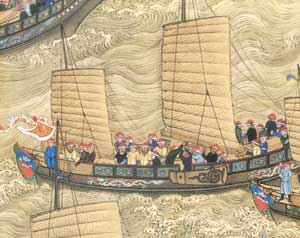 Fig.13 Wang Hui (1632-1717) and assistants, The Kangxi Emperor's Southern Inspection Tour, Scroll Eleven: Nanjing to Jinshan (detail showing officials in armada on Yangtze River from second half of scroll), handscroll, colour on paper, Palace Museum, 67.8 x 2612 cm, cat. no. Gu9208, China: The Three Emperors, 1662-1795, pp.88-89. The Kangxi Emperor commissioned a series of enormous scroll paintings documenting the southern expeditions.[5] The Kangxi Emperor's Southern Inspection Tour, depicting the journey of 1689, originally comprised twelve sections, but some sections have been lost or are incomplete. (Fig.13) The emperor appears once in each section of the work. This considerable project took six years to complete and was overseen by Cao Quan from the Imperial Palace Household. Although the major painter was Wang Hui (1632-1717), other contributing artists were Yang Jin, Leng Mei, Wang Yun and Xu Mei.[6] The Qianlong EmperorEven though the successor of the Kangxi Emperor, the Yongzheng Emperor (r.1723-35), did not travel to the south, the subsequent Qianlong Emperor (r.1736-1795), in little more than 30 years, undertook six southern tours of inspection—in 1751, 1757, 1762, 1765, 1780 and 1784. The first four of these were undertaken in the company of his mother, although the last two voyages were made after her death. Each expedition saw the royal party and retinue leave Beijing in the first month after the conclusion of the New Year celebrations at court and travel overland through Zhili and Shandong to Qingkou in Jiangsu, where they crossed the Yellow River and then proceeded by boat along the Grand Canal, passing in turn through Yangzhou, Zhenjiang, Danyang, Changzhou and Suzhou. (Fig.14) After entering Zhejiang, they continued by canal via Jiaxing and Shimen to Hangzhou. The return route passed through Jiangning (Nanjing), where the emperor paid his respects at the mausoleum of Emperor Taizu of the Ming dynasty and inspected the troops. [7] The party arrived back in Beijing in the last ten days of the fourth lunar month or at the beginning of the fifth. The entire journey covered nearly 2,800 kilometres. 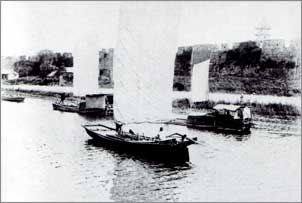 Fig.14 The Grand Canal passing Panmen Gate (photographed before 1920). From Yang Weize ed., Ancient rhythm and present grace, Suzhou: Guwuxuan Chubanshe, 2003, p.25. 'The tendency among historians, however', according to Michael C. Chang, 'has been to assess the Southern Tours almost exclusively as instruments of administration and policy-making, especially in the arena of water control.' [9] On five of his journeys, the Qianlong Emperor inspected the engineering projects in place for controlling the Huai and Yellow rivers and on four occasions he personally surveyed the Jianghai embankments in Zhejiang. These enterprises were close to the political heart of the south which was a source of restiveness under a functional veneer of Manchu-Qing social stability. 'No task of the southern expeditions is more important than supervising the maintenance of the Yellow River', wrote the Qianlong Emperor in his Yuzhi nanxun ji. On the first five of his six expeditions, he made a point of inspecting the Yellow River water conservancy installations at Qingkou and Gaojia Dyke (on the eastern shore of Hongze Lake) at the confluence of the Yellow and Huai rivers. Flooding of the Yellow River caused heavy sedimentation in the Grand Canal disrupting grain transport and adversely affecting social stability. Thus, Qingkou, where the Yellow River entered the sea, and Gaojia Dyke were vital installations for the control of the Yellow River's flow. After inspecting the dykes at Huai'an, the emperor planned to have five more barrages constructed at Hongze Lake, and to supplement the Gaojia Dyke with a stone barrage. He also ordered an embankment be constructed near Gaoyou and a lock at Qingkou, so that when the flood water was at its height the lock could be closed. He also replaced the earth embankments from the Ji Canal to the Grand Canal with brick embankments. These measures were all effective. At the same time, he issued rewards to those officials who made contributions to flood control and management of the Yellow River. In 1757, he offered temple sacrifices to the recently deceased Wen Bin and to Jin Fu and other officials who had served the Kangxi Emperor, to show that the contributions of these officials had not been forgotten. The Qianlong Emperor also made a number of visits to ocean levees. If the levees broke when the annual tidal bore coursed along the Qiantang River in Hangzhou, there would be catastrophic flooding in Haining and Renhe counties, and a number of other nearby places, including Hangzhou, Jiaxing, Huzhou, Suzhou and Changzhou, would also be subject to flooding if the ocean dykes broke. From his third expedition onwards, Qianlong made a point of inspecting the breakwaters at Haining, and over the course of time saw that stone dykes replaced some of the earlier timber dykes. Through his observance of sacrificial ceremonies, the Qianlong Emperor, like his grandfather, also sought to co-opt the literati as a class. The sacrificial ceremonies and commemorative rituals he observed fall into three classes. The first were at temples dedicated to particular deities, the second were grand ceremonies of sacrifice conducted at either the mausoleums of ancestral emperors and kings or at the Temple of Confucius, and the third were commemorative ceremonies held at the temples or graves of eminent historical personages and officials, such as Yue Fei (1103-1142), which were located within thirty li of the route taken by the imperial progress.[10] The Qianlong Emperor devoted most of his attention to sacrifices of the second order. He personally conducted ritual sacrifices at Mingling, the mausoleum of the first emperor of the Ming dynasty, Ming Taizu (Zhu Yuanzhang), and at the mausoleum of the legendary Great Yu at Kuaiji (Shaoxing) in Zhejiang. [11] However one journey to Shandong in 1748, ostensibly to visit the shrine of Confucius in Qufu to conduct rituals, had the more important goal of inspecting areas devastated by drought and hail in the previous year and to dispense aid relief. In a poem documenting this, In Shandong last year the prefectures and counties burdened with disaster were many in number (Shandong shangnian beizai zhouxian poduo), Qianlong voices his compassion: Thinking of the ditches filled [with hunger's corpses], As a result of the emperor's field trip, relief grain was distributed in a number of populous prefectures and counties, including Shouguang, Anqiu, Yidu, Licheng and Qihe, and relief of grain tax was extended to afflicted areas. In line 17 of the same poem, the emperor remarks that such 'tax relief' (xiuzhu) was a hallowed ancient institution, referring indirectly to the idealised well-field system that was extolled in Mencius. A number of other relief measures were implemented in the course of Qianlong's tours of inspection. Reductions in the annual cash and grain tax were extended to the areas through which the expeditions passed. A 30% reduction on the annual tax was extended to Zhili, Shandong, Jiangsu and Jiangsu in the year in which an expedition passed through, and a 50% reduction was extended to areas that had collected disaster relief, such as the provincial capital Jiangning and Suzhou, then simultaneously the capital of Jiangsu province. In areas through which southern expeditions passed, the sentences for some convicted felons were reduced, by way of amnesty. During the last southern expedition of Qianlong, the emperor chose to show his care and concern for residents of drought afflicted areas by extending the reduction of sentences imposed on criminals in Jiangsu, Anhui and Zhejiang to those also living in Zhili and Shandong. Recording his actions in poetry was habitual for the Qianlong Emperor. With nearly 40,000 poems written in his name, Qianlong was the most prolific of China's emperor-poets. While many critics suspect the quality of such a vast output of writing, the poems often provide fresh and, sometimes delightful, comment on places and events, and are accessible to the modern reader. The poems he composed in the course of his southern expeditions exemplified his respect for the cultural history of the areas through which he travelled, and this respect was savoured in his inscriptions which were subsequently displayed at cultural sites.  Fig.15 Tiger Hill, Suzhou. [BGD] The poems supplement the visual spectacle of southern expeditions recorded in the massive hand scrolls produced by court painters, by adding the personal voice of the central player in these progresses. For example, in a poem written on a visit to Tiger Hill in Suzhou, (Fig.15) during his third southern expedition in 1762, the Qianlong Emperor poured scorn on some of the popular mythology surrounding a visit to the site by Qin Shihuang. The tale that the sword of Qin Shihuang had struck the rocky hill and split it to reveal a dark and possibly bottomless spring, which came to be called Sword Pond (Jian Chi), (Figs.16, 17&18) infuriated Qianlong. In a poem he asked, 'Whoever can believe that a sword in flight could have shaped these rocks?'[13] It is difficult to ascertain from his petulant piece whether Qianlong's ire was directed towards Qin Shihuang, or was occasioned by the irritating gullibility of his local informants. In the subsequent line of this short piece, Qianlong took solace in the fact that Confucius refused to discuss the supernatural. Perhaps Qianlong was peeved by the attribution of supernatural powers to Qin Shihuang and was stung that he fell short of his predecessor in the eyes of the locals. It might be an expression of Manchu sensitivity to southern Chinese hostility, because the opening line of the poem, 'Mountains and rivers come into being as part of the cosmic order', could be read as an assertion that his right to rule the geographic sweep of the nation was as firmly grounded in cosmic principles as that of any Chinese emperor. [14]  Fig.16 Sword Lake, Tiger Hill, Suzhou. [BGD]  Fig.17 Sword Lake, Tiger Hill, Suzhou. [BGD]  Fig.18 Sword Lake, Tiger Hill, Suzhou. [BGD]
 Fig.19 Detail showing theatrical performances from Wang Hui and others, The Kangxi Emperor's southern inspection tour: Scroll nine, Gugong Bowuyuan ed., Qingdai gongting huihua, Beijing: Wenwu Chubanshe, 1992, pl.23, p.70. 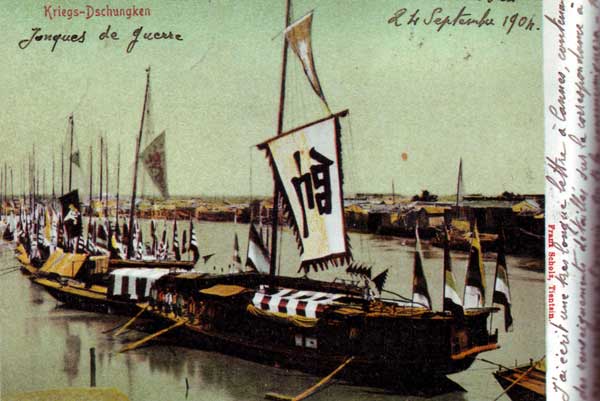 Fig.20 War vessel of the Qing navy for use on the Grand Canal. Source: Mingxinpian: Qingmo Zhongguo (Late-Qing China in post cards), Beijing: Zhongguo Renmin Daxue Chubanshe, 2004, p.180. The southern imperial expeditions also included reviews of troops by the emperor in the provincial centres of Hangzhou and Jiangning, while smaller troop reviews were held in Jingkou, Suzhou and Jiaxing. The military dimension of the tours of inspection is reinforced by the fact that the emperor was accompanied by armed forces, including the equivalent of the navy. (Fig.20) The early Manchu emperors stressed that the Bannermen maintain their military prowess and keep up training. (Fig.21) The troop reviews were designed to ensure military control of the south-east, where anti-Manchu resistance was concentrated after the Qing invasion of China Proper. In the middle period of Qianlong's reign, there was a revival of anti-dynastic unrest from the Small Sword Society (Xiaodao hui). Military discipline slackened among Bannermen stationed in the south, because they did not have the opportunity to practice agriculture, graze their horses or engage in the hunt, and the Lüying (Green Battalion) troops of the Han were quite undisciplined. (Fig.22) At a military review presided over by Qianlong in 1757, the emperor saw Manchu and Green Battalion commanders carried in palanquins, and so he issued the order that they ride horses. Three years later, when he saw a repetition of the phenomenon, he ordered the offenders dismissed from their posts. 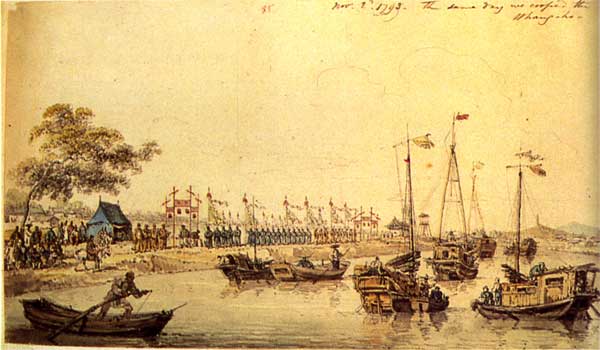 Fig.21 On the Grand Canal, November 2, 1793. The embassy junks saluted by a Chinese military detachment, watercolour, original in British Library manuscript. From Peyrefitte, The collision of two civilisations. 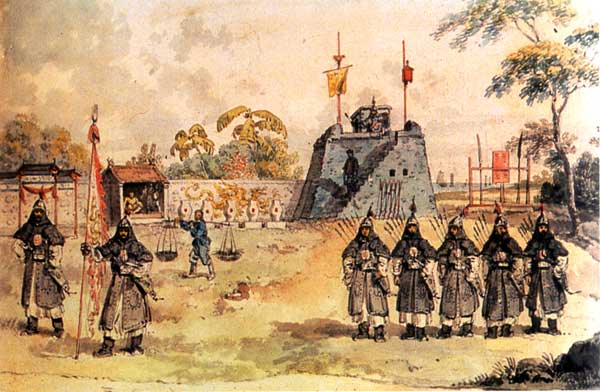 Fig.22 Military post along the Grand Canal, watercolour, original in British Library manuscript. From Peyrefitte, The collision of two civilisations. An End to ExcessCoinciding with times of prosperity, the southern expeditions proved to be an increasing drain on resources, despite the initial austerity they were held to represent. The later tours resulted in lavish expenditure over four or five months, and during the year prior to each expedition a prince of the realm assumed the title of plenipotentiary in charge of travel and activities and would inspect the route and prepare a detailed itinerary and timetable. Local officials would be required to make elaborate preparations, prepare roads, and build xinggong. This all happened despite repeated calls for austerity that were issued in imperial edicts. Local officials so competed to present gifts that many luxury commodities soared in price, and all officials within thirty li of the route along which the expedition traversed were required to wear lavish court dress for the occasion. Needless to say, local corruption soared, and the poor found themselves inconvenienced and disadvantaged by this feast of official spending. This was an effect that the Qianlong Emperor had never imagined that his expeditions would occasion. Yangzhou xinggong mingsheng quantu (Complete illustrated landscapes and imperial lodges of Yangzhou) records that, to receive the Qianlong Emperor during a visit to Yangzhou, the Lianghuai salt merchants accumulated sufficient funds to build or refurbish 5,154 palatial rooms and 196 pavilions, and to fit them out lavishly. According to this source, only ten years before Yangzhou had been a provincial town prior to this unprecedented boom in building luxury accommodation. This was a pattern repeated in other urban centres, including Zhenjiang, Suzhou, Hangzhou and Jiangning, where the emperor was accommodated. The expenditure exceeded the capacity of these towns to provide for the tours. 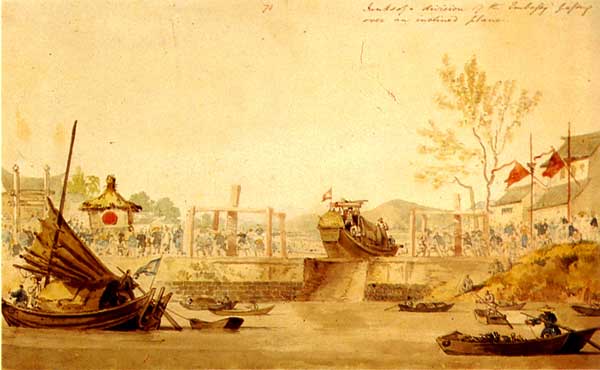 Fig.23 Passing a lock on the Grand Canal, November 16, 1793, watercolour, original in British Library manuscript. From Peyrefitte, The collision of two civilisations. 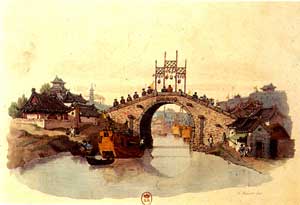 Fig.24 View of Suzhou, watercolour, original in British Library manuscript. From Peyrefitte, The collision of two civilisations. 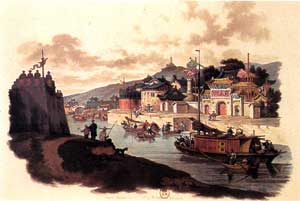 Fig.25 View of Hangzhou, watercolour, original in British Library manuscript. From Peyrefitte, The collision of two civilisations. The expeditions thus ultimately proved detrimental to dynastic rule. The net result was that while the expeditions of the Kangxi Emperor resulted in good governance in the south, the later tours of inspection by the Qianlong Emperor exacerbated tendencies towards corruption and social anomie. Eventually, increased social instability was ushered in by what became lavish exercises in display and ostentation. Some of the dilapidation and decline in the Grand Canal region during the fiscally troubled final years of Qianlong's reign can be glimpsed in the bucolic water colour illustrations (Figs.23, 24&25), produced by William Alexander who accompanied George Macartney, 1st Earl Macartney, on his embassy to the court of Qianlong in 1793. It had been nearly a decade since Qianlong last sailed down the Grand Canal on a southern tour of inspection and the rot had clearly set in. [BGD/ © Bruce Gordon Doar] Notes:[1] The major text treating the southern expeditions and specifically treating the expeditions of four of Qianlong's tours (years 16, 22, 27 and 30 of the Qianlong reign) is a work in 120 juan titled Nanxun shengdian (The grand ritual of the southern expedition), which was edited under the supervision of Gao Jin and presented to the throne in 1771. Published in a reprint edition, Taipei: Xinxing Shuju, 1979. [2] Howard J. Wechsler, Offerings of Silk and Jade: Ritual and Symbol in the Legitimation of the T'ang Dynasty, New Haven and London: Yale University Press, 1985, pp.161-169. [3] See Aisin Gioro Hongli, Zhonghe (Zhonghe Canal), Sun Peiren and Bu Weiyi eds., Qianlong shi xuan (Selected poetry of the Qianlong Emperor, Shenyang: Chunfeng Wenyi Chubanshe, 1987, pp.104-5. [4] See Aisin Gioro Hongli, Ye Konglin lei jiu (Pilgrimage to the Confucian Forest to pour a libation of wine), Sun and Bu, Qianlong shi xuan, pp.281-2. [5] The Metropolitan Museum in New York holds several Qing court paintings documenting the southern expeditions, including The Kangxi Emperor's Southern Tour, Scroll Three: Jinan to Mount Tai, The Qianlong Emperor's Southern Inspection Tour, Scroll Six: Entering Suzhou and the Grand Canal and The Qianlong Emperor's Southern Inspection Tour, Scroll Six: Entering Suzhou and the Grand Canal, all of which can be viewed on the museum's website: http://www.metmuseum.org/ [6] Maxwell K. Hearn in Evelyn S. Rawski and Jessica Rawson eds., China: The Three Emperors, 1662-1795, London: Royal Academy of Arts, 2005, pp.388-9. [7] See Aisin Gioro Hongli, Ye Ming Taizu ling (A respectful visit to the mausoleum of Emperor Taizu of the Ming), Sun and Bu, Qianlong shi xuan, pp.211-2. [8] Yuzhi nanxun ji (The account by the emperor of his southern tour of inspection) is an often quoted document, but the original is relatively unobtainable. According to Michael G. Chang (see f.n.9), the original is the Sazai text of Nanxun shengdian, 1791. See: Sazai et al ed., Qinding nanxun shengdian, Taipei: Taiwan Shangwu Yinshuguan, 1983, juanshou shang 2a. [9] Michael G. Chang, 'Fathoming Qianlong: Imperial activism, the southern tours, and the politics of water control, 1736-1765,' Late Imperial China, The Johns Hopkins University Press, v.24, no.2, December 2003, p.51. [10] See Aisin Gioro Hongli, Jing Yue Wumu Ci (Passing the Shrine of Yue Fei), Sun and Bu, Qianlong shi xuan, pp.100-101. [11] Nanxun shengdian (The grand ritual of the southern expedition). [12] See Aisin Gioro Hongli, Shandong shangnian beizai zhouxian poduo (In Shandong last year the prefectures and counties burdened with disaster were many in number), Sun and Bu , Qianlong shi xuan, pp.75-76. [13] Aisin Gioro Hongli, Jianchi (Sword Lake), Sun and Bu, Qianlong shi xuan, pp.198-9. [14] Ibid., p.198. [15] Li Dou, Yangzhou huafang lu (A record of the decorated boats of Yangzhou), Yangzhou: Jiangsu Guangling Guji Keyinshe, 1984. |